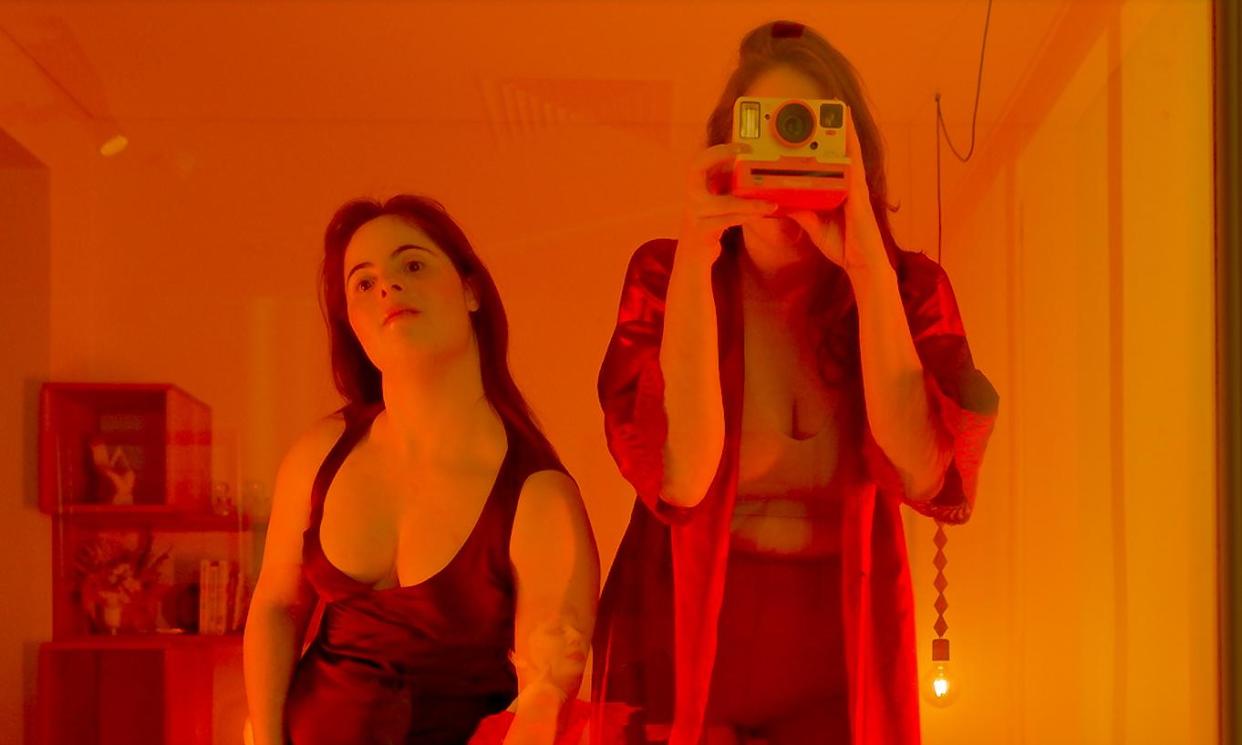The dancers with disability exploring sex and love: ‘Once you open the floodgates, it’s pretty interesting’

In a rehearsal room out the back of Restless Dance Theatre’s Adelaide studio, Michael Hodyl is a lovelorn bowerbird, puffing up his chest and fanning his fingers like feathers. He smooths and preens his suit jacket in a kind of mating dance full of sweeping arm gestures and spins, before picking up a black cardboard box and launching its contents into the air.
As the slips of white paper flutter to the ground around him, Michelle Ryan, artistic director of Restless Dance Theatre, explains that each scrap contains a love note.
“Mike is the romantic, so he knows love’s out there – he writes love notes, and he’s just waiting for someone to arrive,” she says.
Hodyl, 33, is one of the more experienced hands in Restless Dance’s current ensemble. He has Down’s syndrome. He is also a romantic (onstage and off), a Channing Tatum fan, and, according to fellow dancer Jianna Georgiou, a bit of a “drama king”.
“This is my 13th season with Restless – it’s been a journey,” Hodyl says. He loves that dancing allows him to express himself “with a different range of personalities”. “One’s physical, one’s mental – I can do both,” he adds.
Since it was founded in 1991, Restless Dance Theatre has emerged as a unique force in Australian contemporary dance, winning awards and mounting acclaimed runs at Adelaide festival, the Sydney Opera House and Brisbane festival.
Ryan says that Restless Dance’s first call up to the Adelaide festival spotlight in 2017, with its Helpmann-nominated show Intimate Space, had a transformative impact, bringing national and international attention to the group’s work. Performing in theatres as well as unconventional performance spaces like hotels and bowling alleys, the company explores new models for accessibility in the performing arts while also challenging perceptions about disability on and off the stage.
“We explore universal themes that everyone can identify with – then by placing people with disabilities in that space, it changes the lens in which people interpret what they see,” Ryan says.
All our dancers have desires and romantic dreams
Ryan is a dancer herself, performing with Tankard and Australian Dance Theatre before she was diagnosed with multiple sclerosis. She joined Restless Dance in 2013, and over the past decade has developed a choreographic method that is deeply collaborative and led by the dancers themselves.
“We ask the dancers a question – like, ‘how do you show that you are vulnerable?’ – and then they can respond to that physically or in any other way. And it’s then from those answers that we then mould into the choreography,” she says.
“It’s actually finding that essence of them, so that they have a voice in the process, and that they have ownership of what they are making.”
Hodyl is in rehearsal mode for Private View, the company’s fourth appearance at Adelaide festival since 2017. His lovesick bowerbird will open the show – the “headline act”, he says – before three more vignettes explore themes of desire and attraction at different stages of life and love.
“We wanted to look at love and desire and sex and sexuality; these are all things that often are not talked about, especially within the disability sector,” Ryan says. “All our dancers have desires and romantic dreams.”
Ryan and co-director Roz Hervey say Private View’s development was slow but liberating, with an intimacy coach on hand to make sure everyone felt safe and comfortable.
“You can see with the girls; at first you could feel that there was a hesitancy, because they weren’t sure whether they were allowed to discuss their feelings, their views on intimacy,” Ryan adds. “But once you open the floodgates, it’s pretty interesting.”
In another rehearsal room Georgiou and scene partner, Maddy Macera – one of several performers without disability who also appear in Restless productions – run through the show’s third movement. Positioned behind white venetian blinds, the pair play with ideas of voyeurism and power as their eyes and fingers peek out between the slats. As the blinds snap open and shut, Georgiou and Macera are revealed in various flirtatious and playful poses.
Georgiou, who is 32 and has Down’s syndrome, describes herself an “oldie” of the group, having performed with Restless since she was 16. She says dancing makes her feel “strong, confident, spontaneous”.
“I’m more sporty,” she says of her dancing style. “I’m also more interactive with communication through my body, [with] the other dancers in the space.”
Related: Of punk and prizes: notes from the Australian neurodiverse theatre company lauded around the world
In December, Restless Dance received the news that it would receive four years of funding from Creative Australia. It was an important milestone after the company was “blind-sided” in 2020 by a shock omission from the then-Australia Council’s 2021-2024 round – just three weeks after Ryan was granted an Australia Council award for dance.
“I feel like it’s recognition that the company is unique, that we need to have this place,” says Ryan “It gives us that stability, that we can now continue to dream of what we can do in those four years. We’ve got a very ambitious program, it’s really exciting.”
It also recognises the Restless dancers as artists in their own right.
“When I first came to Restless, the dancers weren’t paid,” Ryan says, adding that the implementation of a training program and gym facilities has allowed dancers to develop and flourish in ways that aren’t often afforded to artists with disabilities. “We were very passionate about treating our artists as professionals – their skill level has really soared.”
Private View by Restless Dance Theatre runs from 29 February to 9 March as part of Adelaide festival


